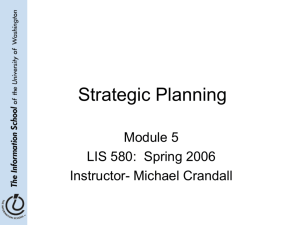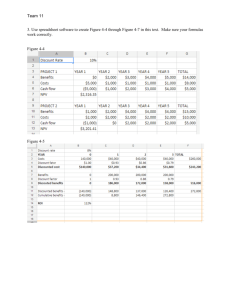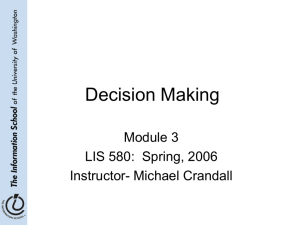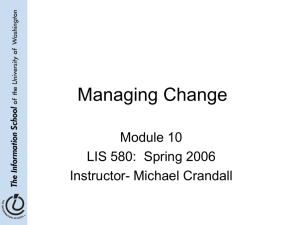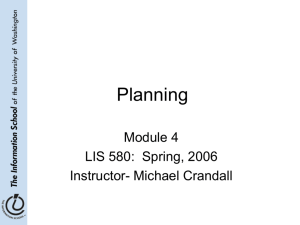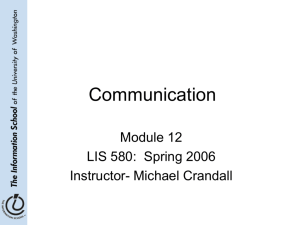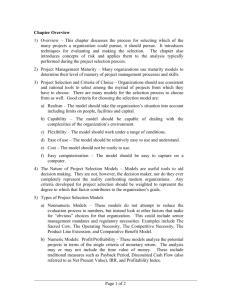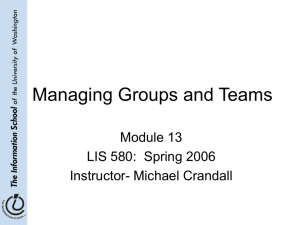Manager
advertisement
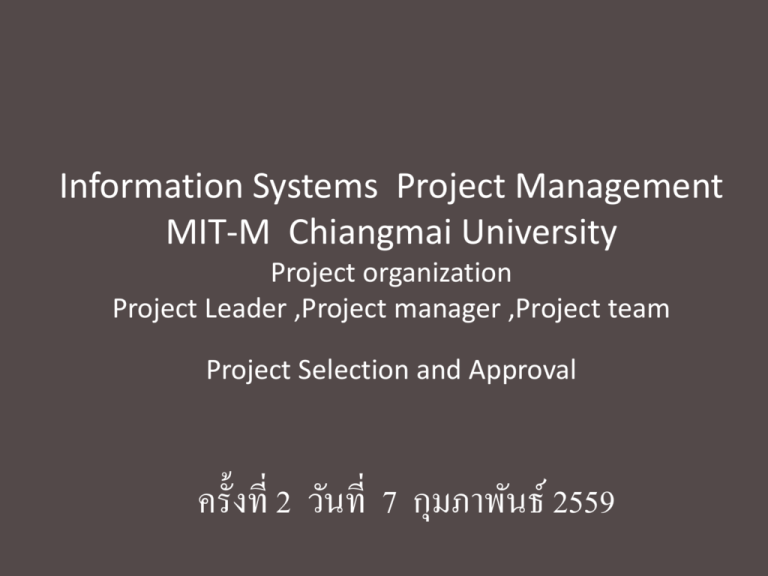
Information Systems Project Management MIT-M Chiangmai University Project organization Project Leader ,Project manager ,Project team Project Selection and Approval ครั้งที่ 2 วันที่ 7 กุมภาพันธ์ 2559 วันนีไ้ ปวัดมาหรื อยัง ไปวัดก่ อนมีทุกข์ ให้ พระนาตอนมีชีวติ อยู่ ทางานหนักตอนมีเวลาก่ อนสอบ วันนีก้ บ็ อกไม่ มเี วลาไปวัด ไปวัดตอนมีทุกข์ ให้ พระนาตอนไม่ มชี ีวติ ขอพระช่ วยตอนหมดเวลา Quotes….. • If you always blame others for your mistakes, you will never improve. • To get a project off the ground, tell a colleague it was their idea. They will put their heart and soul into making it successful. Business View IT View Vision Organization chart IT Vision Mission IT Mission IT Strategy Business Strategy Value chain ตามแต่ละกลยุทธ์ Business Process Level 0 Admin. Operation Support Sub Business Process Level 1 Admin (sale,HR,etc) Operation (Production Process ดูตาม Data requirements Plant Layout) Support (Logistic ,Maintenance) Strategy Execution Technology Potential Business Process Information System Data Matrix IS/IT Application IT Architecture and Infrastructure Functional Existing Software Hardware Needs Software Hardware IS/ IT Projects IS/ IT Investment ระบบสารสนเทศ แบ่งตามระดับชั้นขององค์กร Business Intelligence Executive Inventory Turnover Analysis Sales Analysis EIS Financial Analysis MIS, DSS Knowledge Worker Manager Contents Management Documents Management E-Mail Reports VDO Conference Staff Accounting Information System GL Payroll Finance AP AR Retail Management System Warehouse Barcode System TPS: Transaction Processing System Logistic System CRM System Sales Manage ment IS Application Portfolio Strategic Applications which are critical to sustaining future business strategy Applications on which the organisation currently depends for success Key Operational High Potential Applications which may be of important in achieving future success Applications which are valuable but not critical for success Support Developed from Ward Fig., 1.8 which is sourced from McFarlan Overview and Introduction to Information Systems Project management Enterprise Architecture Business Drivers change Business Strategies Goal Project Organization IS application Portfolio Project Leader User IT IS/IT Projects Define Design Build System delivered Investment objectives Benefit/Change Template IS/IT project , Project Life cycle , Framework of Project management Generic Project Life Cycle Figure 1.4 Systems Development Life Cycle (SDLC) Figure 1.5 The Relationship Between the PLC & SDLC Figure 1.7 หัวข้อวันนี้ 1. อ. เดชนะ มาคุยเรื่ อง การบริหารโครงการอย่างไรให้ สาเร็จด้ วยทีมโครงการ นักศึกษาฟั งจบแล้ วให้ สรุปเนื ้อหาส่งเป็ นกลุม่ และนาไปเป็ นแนวทางประยุกต์ใช้ ในกลุม่ ตัวเอง 2. ส่งรายชื่อกลุม่ และเสนอหัวข้ อโครงการในรูปของ Power point 3. มาวิเคราะห์และอภิปรายโครงการที่เสนอ 1. Project Idea 2. Project Screening and Selection หัวข้อวันนี้ 1. Project Ideas 2. Project Screening 3. Project Selection and Approval 4. 5. 6. 7. Project Organization Project Leader Project Manager Project Team Leaders vs. Business Model "They are the most innovative" Product Leadership "Constantly renewing and creative" "Always on the leading edge" "A great deal!" Operational Excellence Excellent/attractive price Minimal acquisition cost and hassle Lowest overall cost of ownership "A no-hassles firm" Convenience and speed Reliable product and service www.myCNI.com.my Customer Intimacy "Exactly what I need" Customized products Personalized communications "They're very responsive" Preferential service and flexibility Recommends what I need "I'm very loyal to them" Helps us to be a success www.OOBEY.com Leaders vs. Business Model: Disciplines, Priorities, and KPIs Operational Excellence Product Leadership Customer Intimacy • New, state of the art products or services • Management by Fact • Competitive price • Error free, reliable • Risk takers • • Fast (on demand) • • Simple Meet volatile customer needs Easy to do business with • • Responsive Fast concept-tocounter Have it your way (customization) • • Consistent information for all Market segments of one • Proactive, flexible • Relationship and consultative selling • Cross selling • Transactional • 'Once and Done' www.myCNI.com.my • • • Never satisfied obsolete own and competitors' products Learning organization www.OOBEY.com Selection Methods - Following is an illustration of two of methods (Benefit Measurement and Constrained Optimization methods). Common methods used in Project Selection Decision • Economic & Financial – payback – cost-benefit – npv/irr 68% 63% 40% • Multifactor – Checklist- minimum acceptable level of requirements – project profile- strength and weakness – scoring/rating models – multicriteria • Mathematical Programming- optimal solution for projects • Expert Systems- systematic manner 38% 26% 26% 11% 18% 6% Figure 4-2. Net Present Value Example 19 Note that totals are equal, but NPVs are not because Figure 4-3. JWD Consulting NPV Example Multiply by the discount factor each year, then subtract costs from cumulative benefits to get NPV. Note: See the template called business_case_financials.xls. 20 Weighted scoring model Criteria Weight Project 1 Project2 project3 criteria1 25% 90 90 50 criteria2 30% 70 90 50 Criteria3 40% 50 80 60 Criteria4 5% 80 90 50 Weighted project score 100% 67.5 86 54 Figure 4-5. Sample Weighted Scoring Model for Project Selection 22 Priority Analysis 23 Figure 4-5. Sample Weighted Scoring Model for Project Selection 24 Project Screening Matrix FIGURE 2.3 25 รู ปแบบโครงสร้างองค์กร วัตถุประสงค์ เป้าหมาย ยุทธศาสตร์ 1. Functional 2. Project 3. Matrix Report structure Decision structure Communication structure เป้าหมาย Role ภารกิจ Project Leader Responsibility & Authority Accountability , Delegation Leader Project Manager Project Team โครงสร้างเป็ นทางการ Culture Norm Delegation โครงสร้างไม่เป็ นทางการ Group Process Trust Trust Responsibility Socialization Authority จิตใจแบบตะวันตก Maslow Needs Theory จิตใจแบบตะวันออก High-level Project Organization Chart Senior Leadership Serve as champions for the project and provide high-level direction, authority, decision-making and resources for the project. Provides subject matter expertise and functional ownership and accountability for project results. Executive Sponsor Sponsor Advisory or Steering Team Supports the sponsor(s) and project leader. Provides high-level direction, input, and decision making. Project Leadership Project Project Manager Leader Project Work Teams Functional Team Provides project management, process improvement, and change management process expertise, tracking, and reporting. Core Team Functional Team Functional Team Provides the subject matter expertise and day-to-day planning and implementation for the respective functional area(s). Resolves issues and escalates when required. Project Resources Critical resources that can be brought in as subject matter experts as needed. Provides day-to-day leadership for the planning, implementation, and closing of the project. Resolves issues and escalates when required. Assesses change management needs and develop strategies. Implements communication plan. Leads the individual functional teams. Table 2-1. Organizational Structure Influences on Projects The organizational structure influences the project manager’s authority, but project managers need to remember to address the human resources, political, and symbolic frames, too. 28 IT Project Management, Third Edition Chapter 2 Designing Organizations to Manage Teams Source: Adapted from James H. Shonk, Team-Based Organizations (Homewood, IL: Irwin, 1997), p. 36. May 9, 2006 LIS580- Spring 2006 FIGURE 13–5 G.Dessler, 2003 29 Managing & Leading “Managers are people who do things right and leaders are people who do the right thing.” – Bennis and Nanus, 1985 “Most U.S. corporations today are over-managed and under led.” – Kotter, Harvard Business Review 2001 Enforcing Standards Resolving Issues Budgeting Planning Reviewing Status Coaching Providing Vision Motivating Aligning Stakeholders Demonstrating Standards and Providing Structure Table 2-4. Most Significant Characteristics of Effective and Ineffective Project Managers Effective Project Managers • • • • • • • Lead by example Are visionaries Are technically competent Are decisive Are good communicators Are good motivators Stand up to upper management when necessary • Support team members • Encourage new ideas 32 Ineffective Project Manag • • • • • Set bad examples Are not self-assured Lack technical expertise Are poor communicators Are poor motivators IT Project Management, Third Edition Chapter 2 Skills Required Facilitation & Chairing Team Management People Skills Leadership Styles Project Management Decision Making Time Management Communication Problem Solving Providing an Organizational Context That Supports Teams Organizational Structure Organizational Systems Team Work Approach Organizational Policies Employee Skills G.Dessler, 2003 May 9, 2006 LIS580- Spring 2006 34 Team Leader Roles Prentice Hall, 2002 May 9, 2006 LIS580- Spring 2006 35 Characteristics of High-performing Work Teams May 9, 2006 LIS580- Spring 2006 Prentice Hall, 2002 36 Team Leader Behaviors Druskat, V.U. & J.V. Wheeler. (2004). How to Lead a Self-Managing Team May 9, 2006 LIS580- Spring 2006 37 Effective Project Teams Clear Sense of Mission Productive Interdependency Cohesiveness Trust Enthusiasm Results Orientation 6-38 Reasons Why Teams Fail • Poorly developed or unclear goals • Poorly defined project team roles & • • • • • interdependencies Lack of project team motivation Poor communication Poor leadership Turnover among project team members Dysfunctional behavior 6-39 Why Teams Fail: The Leadership, Focus, and Capability Pyramid Source: Adapted from Steven Rayner, “Team Traps: What They Are, How to Avoid Them.” National Productivity Review. Summer 1996, p. 107. Reprinted by permission of John Wiley & Sons, Inc. FIGURE 13–3 May 9, 2006 LIS580- Spring 2006 G.Dessler, 2003 40 Stages in Group Development 1. Forming – members become acquainted 2. Storming – conflict begins 3. Norming – members reach agreement 4. Performing – members work together 5. Adjourning – group disbands Punctuated Equilibrium is a different model 6-41 Team Development Stages 4. Performing Adjourn 1. Forming Trust Flexible Supportive Confident Efficient High Morale Productiv e Organized Establish procedures Develop team skills Confront issues Rebuilding morale 3. Norming Convene Quiet Polite Guarded Impersonal Business-like High Morale Testing Infighting Conflict over control Confrontational Alienation Personal agendas Low morale 2. Storming 6-42 หัวข้อเรี ยนและมอบหมายงานครั้งต่อไป 1. งานค้นคว้าเดี่ยว Project Planning ,Project charter ,Project Estimation 2. งานกลุ่ม ไปวางแผนโครงการแล้วนามาเขียนเป็ นข้อเสนอโครงการ ตามหลักการตามที่คน้ มา Project Proposal (Logic chart) , Project Charter , Work Breakdown Structure (WBS) เตรี ยมมานาเสนอในรู ป ของ Power point 2. เริ่ มไปทา Project Estimation



